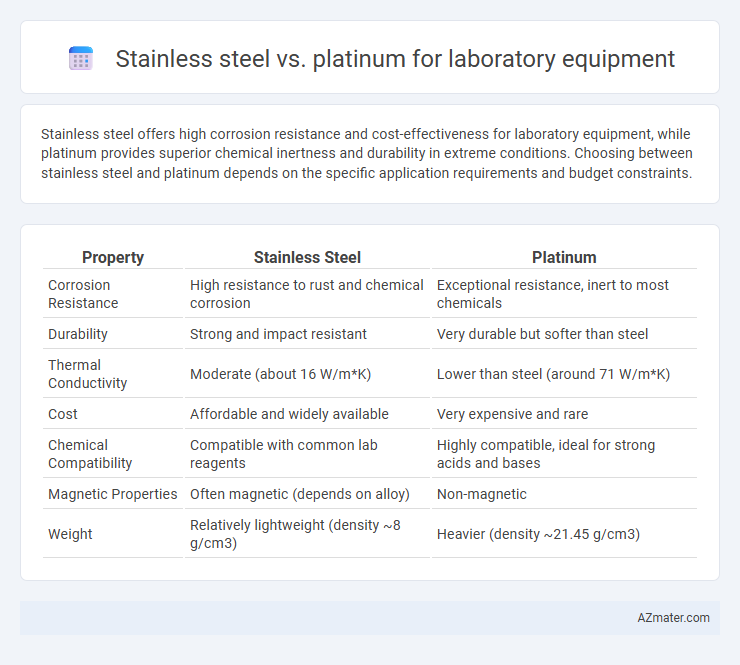Stainless steel offers high corrosion resistance and cost-effectiveness for laboratory equipment, while platinum provides superior chemical inertness and durability in extreme conditions. Choosing between stainless steel and platinum depends on the specific application requirements and budget constraints.
Table of Comparison
| Property | Stainless Steel | Platinum |
|---|---|---|
| Corrosion Resistance | High resistance to rust and chemical corrosion | Exceptional resistance, inert to most chemicals |
| Durability | Strong and impact resistant | Very durable but softer than steel |
| Thermal Conductivity | Moderate (about 16 W/m*K) | Lower than steel (around 71 W/m*K) |
| Cost | Affordable and widely available | Very expensive and rare |
| Chemical Compatibility | Compatible with common lab reagents | Highly compatible, ideal for strong acids and bases |
| Magnetic Properties | Often magnetic (depends on alloy) | Non-magnetic |
| Weight | Relatively lightweight (density ~8 g/cm3) | Heavier (density ~21.45 g/cm3) |
Introduction to Laboratory Equipment Materials
Stainless steel and platinum are two widely used materials for laboratory equipment due to their distinct chemical and physical properties. Stainless steel offers high corrosion resistance, durability, and affordability, making it ideal for general lab instruments and containers. Platinum, valued for its exceptional inertness and resistance to high temperatures and chemical attacks, is preferred in specialized applications requiring non-contaminating and long-lasting materials.
Key Properties of Stainless Steel
Stainless steel offers exceptional corrosion resistance, high tensile strength, and excellent durability, making it ideal for laboratory equipment exposed to various chemicals and high temperatures. Its non-porous surface ensures easy cleaning and sterilization, maintaining laboratory hygiene standards. Compared to platinum, stainless steel is more cost-effective while providing sufficient chemical resistance and mechanical robustness for most laboratory applications.
Key Properties of Platinum
Platinum offers exceptional corrosion resistance and high catalytic activity, making it ideal for use in laboratory equipment exposed to aggressive chemicals and high temperatures. Its excellent electrical conductivity and stability under extreme conditions ensure precise experimental results and long-term durability. Compared to stainless steel, platinum's inert nature prevents contamination and maintains purity in sensitive analytical processes.
Durability and Corrosion Resistance
Stainless steel exhibits excellent durability and high resistance to corrosion, making it a preferred choice for laboratory equipment exposed to a wide range of chemicals and high temperatures. Platinum offers superior corrosion resistance, especially against aggressive acids and oxidizing agents, and maintains its integrity over prolonged use in highly corrosive environments. While stainless steel is cost-effective and robust, platinum provides unmatched longevity and stability in extreme chemical conditions.
Chemical Compatibility and Reactivity
Stainless steel offers excellent chemical resistance against many acids, alkalis, and organic compounds, making it suitable for general lab equipment, but may corrode when exposed to strong acids like hydrochloric or hydrofluoric acid. Platinum exhibits superior chemical inertness and resists virtually all acids, high temperatures, and oxidizing environments without degradation, ideal for highly reactive or corrosive substances. Selecting platinum minimizes reactivity risks, while stainless steel balances cost and chemical compatibility for less aggressive laboratory applications.
Cost Comparison: Stainless Steel vs Platinum
Stainless steel offers a significantly lower cost compared to platinum, making it the preferred choice for most laboratory equipment due to its affordability and durability. Platinum, while excellent in corrosion resistance and chemical inertness, carries a substantially higher price tag, often limiting its use to specialized applications requiring extreme chemical resistance. Laboratories must weigh the cost-effectiveness of stainless steel against the premium investment in platinum for high-precision or highly corrosive environments.
Maintenance and Longevity
Stainless steel offers excellent corrosion resistance and requires low maintenance, making it durable for repeated laboratory use. Platinum, while more expensive, provides superior chemical inertness and resists tarnishing, ensuring long-term stability in highly reactive environments. Both metals have considerable longevity, but platinum's superior resistance to harsh chemicals often results in a longer functional lifespan for specialized lab equipment.
Common Laboratory Applications
Stainless steel is widely utilized in laboratory equipment due to its excellent corrosion resistance, durability, and cost-effectiveness, making it ideal for autoclaves, sinks, and storage containers. Platinum offers superior chemical inertness and high melting points, making it essential for crucibles, electrodes, and specialized heating elements used in high-temperature or highly corrosive environments. Both materials are selected based on application-specific requirements, with stainless steel preferred for general labware and platinum reserved for precision tasks demanding exceptional resistance and stability.
Environmental and Safety Considerations
Stainless steel is favored in laboratory equipment for its corrosion resistance, durability, and recyclability, contributing to lower environmental impact through extended lifespan and reduced waste. Platinum offers exceptional chemical inertness and high-temperature resistance, ensuring safety when handling reactive substances, but its mining and refining processes have greater ecological footprints. Choosing stainless steel reduces environmental hazards and energy consumption during manufacturing, while platinum excels in applications demanding superior chemical safety despite higher environmental costs.
Choosing the Right Material for Your Laboratory Needs
Stainless steel offers exceptional corrosion resistance, durability, and cost-effectiveness, making it ideal for general laboratory equipment and environments involving moderate chemical exposure. Platinum provides superior chemical inertness and high-temperature resistance, crucial for handling aggressive reagents and precise analytical applications. Selecting between stainless steel and platinum depends on the chemical compatibility, thermal stability, and budget requirements specific to your laboratory processes.

Infographic: Stainless steel vs Platinum for Laboratory equipment
 azmater.com
azmater.com